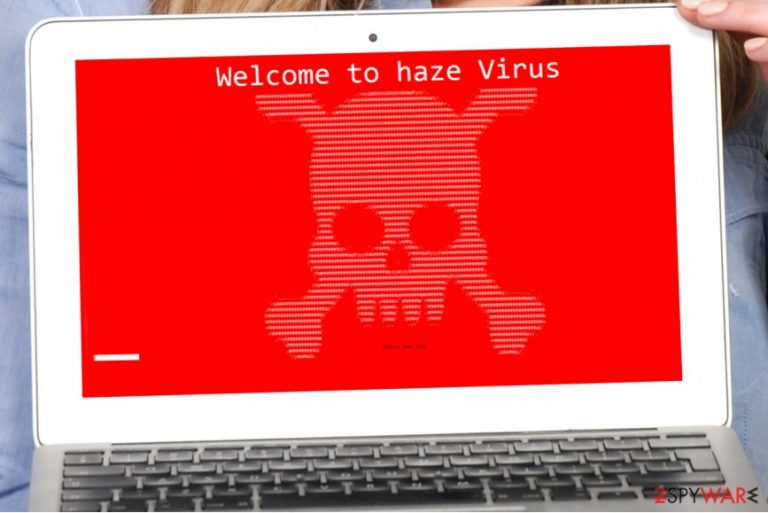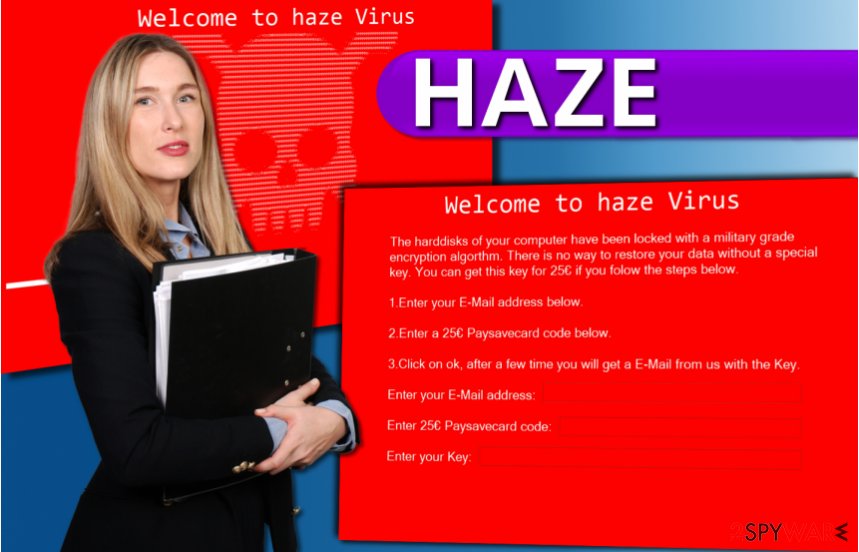Haze ransomware / virus (Tutorial) - Bonus: Decryption Steps
Haze virus Removal Guide
What is Haze ransomware virus?
Haze ransomware pretends to be Petya to scare computer users

Haze ransomware is another suspicious virus that was first spotted on August 30. The malicious program lacks technical ransomware features and works as a screen-locking malware only. It displays a Petya-inspired[1] red window with ASCII skull on it.
The virus doesn’t encrypt[2] your files, so you just need to remove Haze virus in order to continue using your PC.
Haze ransomware suggests pressing any key to see a message from the criminals. The message says:
Welcome to haze Virus
The hard disks of your computer have been locked with a military grade encryption algorithm. There is no way to restore your data without a special key. You can get this key for 25€ if you follow the steps below.
Haze virus asks to provide the victim’s email address and a code of a Paysafecard worth 25€. The virus suggests clicking the “OK” button to send the information to criminals in order to receive a “key” to unlock the computer.
Clearly, there is no need to pay the ransom since there is no real danger of losing your files – remove Haze ransomware and protect your computer to prevent similar ransomware attacks in the future.
For a successful Haze removal, we recommend using a trustworthy anti-malware tool such as FortectIntego. You can also clean your computer using programs like SpyHunter 5Combo Cleaner or Malwarebytes. Please start these programs only after rebooting your PC into Safe Mode with Networking (a tutorial on how to do it is given below the article).

Distribution of the virus
The virus might reach your computer in the form of a ZIP file, which means that the distributors of it are using the malspam technique to spread the malware. Be aware that scammers might try to trick you into opening the malicious ransomware executive by wrapping it into a Word or JS file which might be archived using 7-Zip.
We strongly recommend you to be suspicious of emails you receive from slightly suspicious individuals or companies. You should never rush to open a file or a link if you are not 100% sure that the sender is a trustworthy one.
Another suggestion is to always save files to your computer before opening them – this way, your security programs will have time to check the file and tell you whether it is dangerous or not.
The ransomware that inspired Haze's authors mainly attacked Ukraine, although it compromised hundreds of computers worldwide. At the moment, it seems that the fake copy of the virus (described in this article) spreads on a global scale as well, firstly attacking German and French[3] computer users.
Remove Haze ransomware and regain access to your PC
Remove Haze virus because it only creates additional vulnerabilities in your computer system. Besides, it might be using your Internet connection to transmit information about you to criminals. To delete the virus and clean up the entire computer, let anti-malware programs help you.
We suggest completing Haze removal with programs like FortectIntego. However, the ransomware can attempt to block your security programs from doing their job. To allow security programs remove the malware, you must start them while in Safe Mode. A guide on how to prepare your computer is provided below.
Getting rid of Haze virus. Follow these steps
Manual removal using Safe Mode
Restore your computer using the guide provided below. After removing Haze virus, you will access your computer system again.
Important! →
Manual removal guide might be too complicated for regular computer users. It requires advanced IT knowledge to be performed correctly (if vital system files are removed or damaged, it might result in full Windows compromise), and it also might take hours to complete. Therefore, we highly advise using the automatic method provided above instead.
Step 1. Access Safe Mode with Networking
Manual malware removal should be best performed in the Safe Mode environment.
Windows 7 / Vista / XP
- Click Start > Shutdown > Restart > OK.
- When your computer becomes active, start pressing F8 button (if that does not work, try F2, F12, Del, etc. – it all depends on your motherboard model) multiple times until you see the Advanced Boot Options window.
- Select Safe Mode with Networking from the list.

Windows 10 / Windows 8
- Right-click on Start button and select Settings.

- Scroll down to pick Update & Security.

- On the left side of the window, pick Recovery.
- Now scroll down to find Advanced Startup section.
- Click Restart now.

- Select Troubleshoot.

- Go to Advanced options.

- Select Startup Settings.

- Press Restart.
- Now press 5 or click 5) Enable Safe Mode with Networking.

Step 2. Shut down suspicious processes
Windows Task Manager is a useful tool that shows all the processes running in the background. If malware is running a process, you need to shut it down:
- Press Ctrl + Shift + Esc on your keyboard to open Windows Task Manager.
- Click on More details.

- Scroll down to Background processes section, and look for anything suspicious.
- Right-click and select Open file location.

- Go back to the process, right-click and pick End Task.

- Delete the contents of the malicious folder.
Step 3. Check program Startup
- Press Ctrl + Shift + Esc on your keyboard to open Windows Task Manager.
- Go to Startup tab.
- Right-click on the suspicious program and pick Disable.

Step 4. Delete virus files
Malware-related files can be found in various places within your computer. Here are instructions that could help you find them:
- Type in Disk Cleanup in Windows search and press Enter.

- Select the drive you want to clean (C: is your main drive by default and is likely to be the one that has malicious files in).
- Scroll through the Files to delete list and select the following:
Temporary Internet Files
Downloads
Recycle Bin
Temporary files - Pick Clean up system files.

- You can also look for other malicious files hidden in the following folders (type these entries in Windows Search and press Enter):
%AppData%
%LocalAppData%
%ProgramData%
%WinDir%
After you are finished, reboot the PC in normal mode.
Remove Haze using System Restore
-
Step 1: Reboot your computer to Safe Mode with Command Prompt
Windows 7 / Vista / XP- Click Start → Shutdown → Restart → OK.
- When your computer becomes active, start pressing F8 multiple times until you see the Advanced Boot Options window.
-
Select Command Prompt from the list

Windows 10 / Windows 8- Press the Power button at the Windows login screen. Now press and hold Shift, which is on your keyboard, and click Restart..
- Now select Troubleshoot → Advanced options → Startup Settings and finally press Restart.
-
Once your computer becomes active, select Enable Safe Mode with Command Prompt in Startup Settings window.

-
Step 2: Restore your system files and settings
-
Once the Command Prompt window shows up, enter cd restore and click Enter.

-
Now type rstrui.exe and press Enter again..

-
When a new window shows up, click Next and select your restore point that is prior the infiltration of Haze. After doing that, click Next.


-
Now click Yes to start system restore.

-
Once the Command Prompt window shows up, enter cd restore and click Enter.
Bonus: Recover your data
Guide which is presented above is supposed to help you remove Haze from your computer. To recover your encrypted files, we recommend using a detailed guide prepared by 2-spyware.com security experts.If your files are encrypted by Haze, you can use several methods to restore them:
Finally, you should always think about the protection of crypto-ransomwares. In order to protect your computer from Haze and other ransomwares, use a reputable anti-spyware, such as FortectIntego, SpyHunter 5Combo Cleaner or Malwarebytes
How to prevent from getting ransomware
Stream videos without limitations, no matter where you are
There are multiple parties that could find out almost anything about you by checking your online activity. While this is highly unlikely, advertisers and tech companies are constantly tracking you online. The first step to privacy should be a secure browser that focuses on tracker reduction to a minimum.
Even if you employ a secure browser, you will not be able to access websites that are restricted due to local government laws or other reasons. In other words, you may not be able to stream Disney+ or US-based Netflix in some countries. To bypass these restrictions, you can employ a powerful Private Internet Access VPN, which provides dedicated servers for torrenting and streaming, not slowing you down in the process.
Data backups are important – recover your lost files
Ransomware is one of the biggest threats to personal data. Once it is executed on a machine, it launches a sophisticated encryption algorithm that locks all your files, although it does not destroy them. The most common misconception is that anti-malware software can return files to their previous states. This is not true, however, and data remains locked after the malicious payload is deleted.
While regular data backups are the only secure method to recover your files after a ransomware attack, tools such as Data Recovery Pro can also be effective and restore at least some of your lost data.
- ^ Olivia Solon, Alex Hern. 'Petya' ransomware attack: what is it and how can it be stopped?. The Guardian - Technology. Latest Technology News, Comment and Analysis.
- ^ Rick Correa. How Fast Does Ransomware Encrypt Files? Faster than You Think. Barkly Endpoint Security Blog. The Latest Endpoint Security News, Tips, and Actionable Insights.
- ^ LesVirus.fr official website. LesVirus. Malware Removal Guides, Security News.







